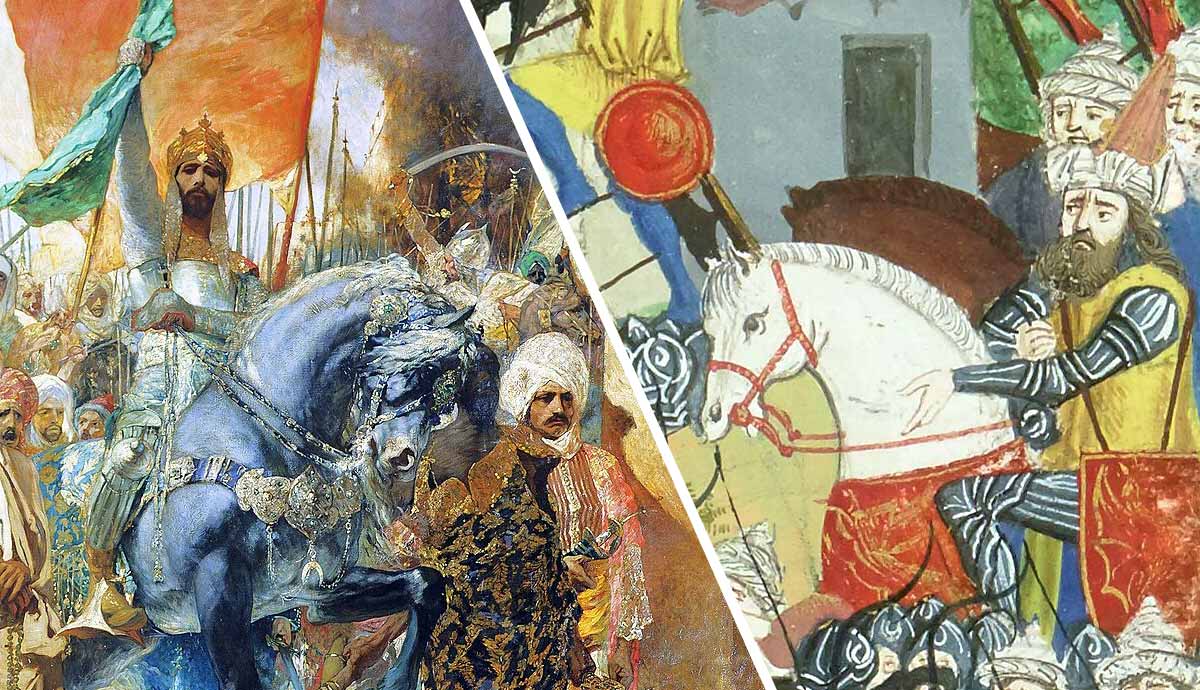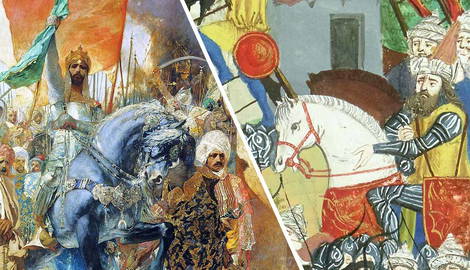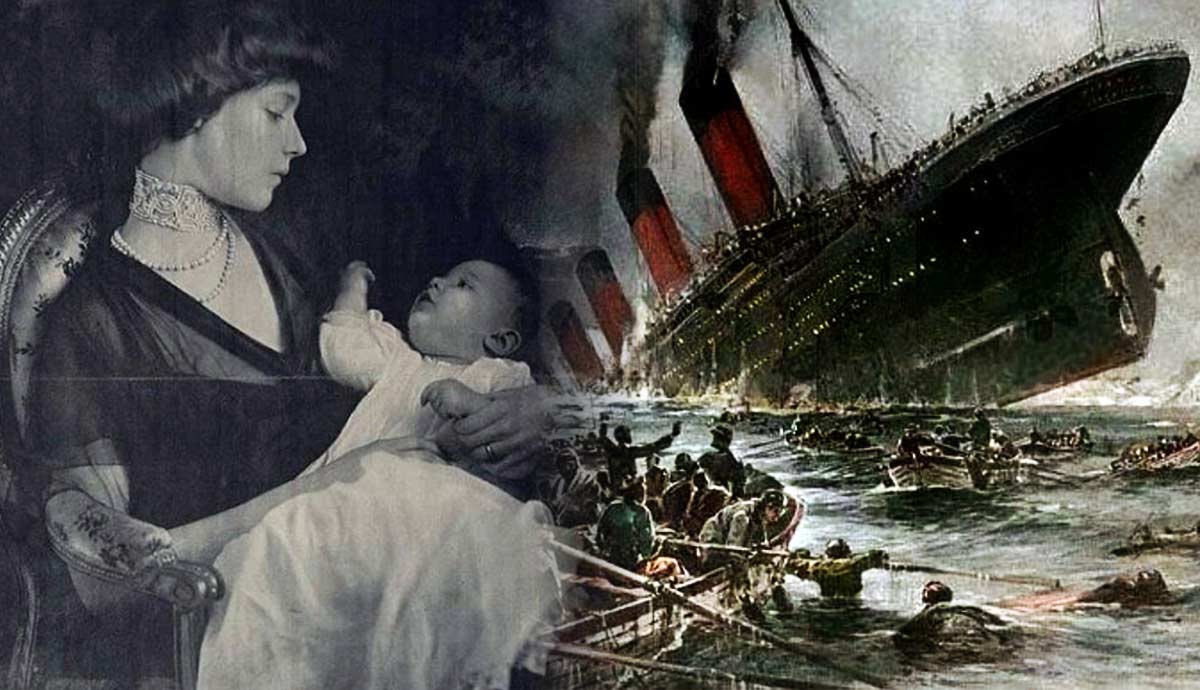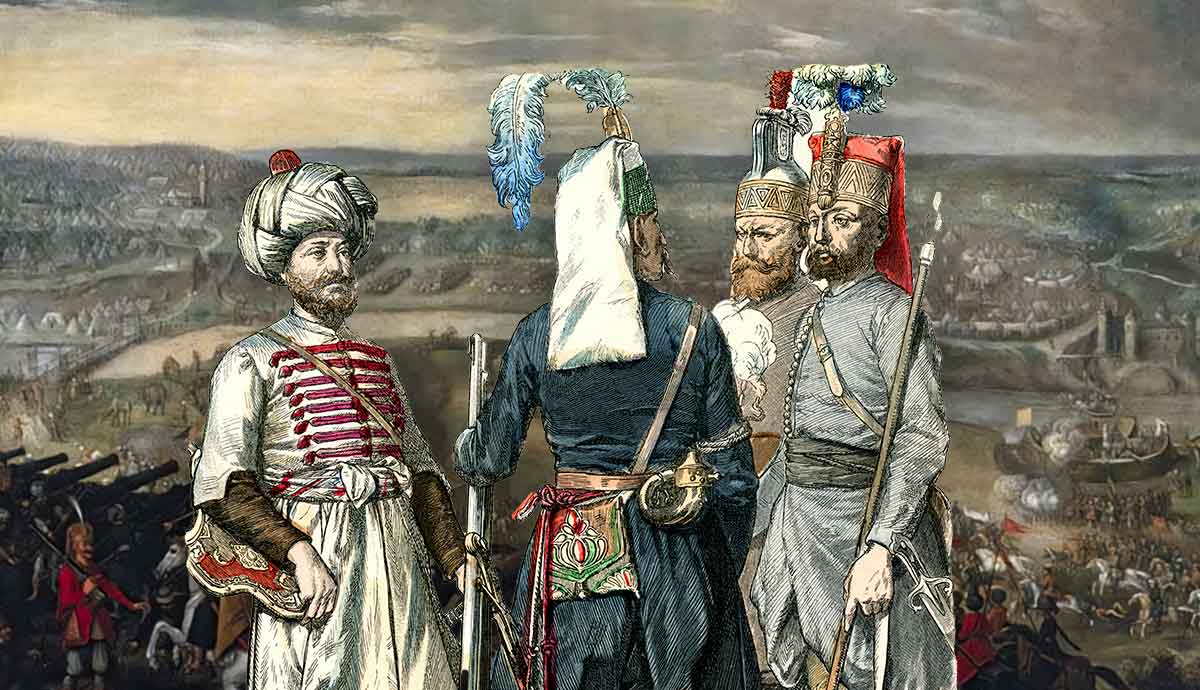
On April 2, 1453, Constantine XI, Emperor of the Romans (Byzantines), stood on top of the battlements of Constantinople, watching as the mighty Ottoman army of Sultan Mehmed II, approached his capital. The Ottoman army was immense, Mehmed had brought with him the full force of his military might which numbered between 60,000 and 80,000 men, and a naval force of 320 vessels.
Read on to discover the full story of the fall of Constantinople.
Mehmed II Conquering Constantinople

This was far from the first siege the “Queen of Cities” had suffered. In its long history, Constantinople endured numerous sieges from the Goths, Sassanids, Avars, Arabs, Bulgars, Russians, Crusaders, and even a few Byzantine rebel armies themselves. Very few of these had any success against the masterworks of defenses of ditches, moats, towers, gates, and a 20 kilometer (12 mile) network of walls that protected the city. This was not even the first Ottoman siege of Constantinople; the Turks tried and failed to capture the city in 1391, 1394-1402, 1411, and again in 1452.
The Ottoman Army and Mehmed’s Monster

The army that Mehmed II brought to the walls, however, was different from the armies that came before it; trailing behind his armed forces were 69 cannons. The largest of these was a gargantuan gun named the Basilic, so immense in size that it had to be moved by 90 oxen and 400 men, built for the express purpose of pounding the walls of Constantinople to dust. The gun was 7.3 meters (24 feet) in length, weighing more than 18,000 kilograms (20 tons), and was able to fire a cannonball of 550 kg (0.6 tons) over 1.6 kilometers (one mile). The age of gunpowder had arrived.
The monstrous cannon was the creation of Orbán (or Urban), a Hungarian engineer, iron founder, and gunsmith who originally offered his services to the Byzantines. When Emperor Constantine XI could not afford his services, Orbán turned to the Ottoman sultan. When Mehmed asked if his creations could break through the walls of Constantinople the engineer replied: “I can cast a cannon of bronze with the capacity of the stone you want. I have examined the walls of the city in great detail. I can shatter to dust not only these walls with the stones from my gun, but the very walls of Babylon itself.”
The Fading Light of Rome

The Byzantine Empire, once the superpower of the Middle Ages and the bulwark of Christendom against Islam, was a shadow of its former self. Byzantium’s numerous wars against countless waves of enemies from all sides, its myriad civil wars, deep-rooted corruption, political infighting, and a series of inept emperors had all taken their toll on the empire.
While its fortifications were still the most impressive and formidable defenses in the medieval world, Constantinople, the capital of an empire that was once the jewel of the Mediterranean, had fallen on hard times. Boasting a population of 400,000 in the 12th century, the city was now home to less than 50,000 people. Wide open fields where bustling markets and lively neighborhoods once stood, now dotted much of the space inside the walls.
Financial strain and the dwindling population of Constantinople meant that the city had insufficient manpower to resist the Ottomans. Giacomo Tedaldi, an eyewitness to the siege, reported that there were 30,000 to 35,000 civilians pressed into armed service but only 6,000 to 7,000 “real soldiers.”
The Archbishop Leonard of Chios mentioned that “Those who were skilled in the use of the bow or the crossbow were not enough to man all the ramparts.” The defenders had a few cannons of their own, about 15 in total, but most were restricted to anti-personnel use. One of the larger cannons that could be used against the enemy’s artillery gave a good account of itself but burst in the early days of the siege.
The Beginning of the End

By April 5, the Ottoman forces had surrounded the land walls while the Ottoman navy had blockaded the entrance to the Bosporus, preventing any outside aid from reaching the city, or any of the inhabitants escaping. Unlike so many of the prior sieges that the inhabitants of Constantinople suffered, there would be no free flow of supplies in or out of the city’s harbor.
With the city blocked off, Mehmed sent an emissary to demand the immediate unconditional surrender of Constantinople. The emissary was met with no response and the following day, April 6, the bombardment of the city from the Basilic and other cannons commenced.
The cannons thundered until the next day when a section of the wall collapsed under the pounding. The Ottomans then attempted their first assault on the walls, but this was easily repulsed by the defenders and the breach was repaired overnight, filled in with earth, bricks, stone, and other rubble. There was a small respite when the Ottomans repositioned some of their cannons but on April 11, the relentless roaring bombardment once again began.
Big, Slow, and Hot

Among these was Orbán’s behemoth, the Basilic. The cannon however was so large and cumbersome that it took hours to load and fire. It came in two parts and had to be taken apart to be reloaded. A copious amount of gunpowder went into the rear end while the half-ton granite ball was placed in the front section before being screwed back together.
It was positioned on a platform comprised mostly of mud with wooden logs wedged in next to the sides of the cannon to create stability. The fuse was lit and what followed was a deafening explosion that hurled a massive cannonball at the walls of Constantinople. Not only did it cause immense devastation to the fortifications it hit, but also devastated the morale of the defenders. The immense recoil even crushed some of its own operators.

The heat emanating from the cannon after it was fired was so hot that it overheated the gun and it had to be covered in warm olive oil to prevent the cold air from cracking the barrel. The gun had to cool down before the laborious task of loading the gun started again. The whole protracted process was so painstakingly slow that the gun could only fire between three and seven shots a day, allowing the defenders to make crucial repairs to the walls between shots. The smaller cannons however could shoot roughly 100 times a day, chipping away at the defences of Constantinople.
A Call to the West

While outnumbered and outgunned, the defenders put up a desperate fight. They repelled several assaults on the walls, hampered the enemy with their stone throwers and few cannons, and even performed several sorties against the Ottoman siegeworks. At night, work teams set out to repair the damaged walls. Despite their brave efforts, there was no doubt that barring outside help, Constantinople was holding out on borrowed time.
Prior to the siege, Constantine had sent our pleas for help to the Christian rulers in the West. The emperor’s pleas to the Pope were unfruitful as Constantine underestimated the influence the leader of the church had over the Western powers. More importantly, France and England were embroiled in the Hundred Years War, Spain was enmeshed in the Reconquista, and the Holy Roman Empire was politically unstable. Hungary and Poland were still trying to recover from the defeat of Varna in 1444, while Venice’s promises of support were hollow.
The Battle for the Golden Horn

On April 12, Mehmed sent contingents of his army to capture the Byzantine fortresses at Studios and Therapia, tightening the noose around Constantinople. At the same time, the Ottoman fleet attempted an attack on the harbor of Constantinople but the great chain across the mouth of Golden Horn proved too much for the Turkish fleet and was driven back twice by the smaller Christian fleet.
On April 17, Mehmed ordered a daring night attack on the walls but after a desperate four-hour-long struggle the Ottomans were once again driven back. At the same time, the Ottoman navy was sent to capture the nearby Princes’ Islands. However, on April 20, a fleet of three Genoese vessels, sent by the Pope and filled with supplies, along with a large Byzantine ship laden with wheat, managed to slip past the Ottoman blockade.
Mehmed was enraged at the failure of his admiral and had the man stripped of his rank and property and publicly flogged. This was such a blow to the besiegers and such a boost of morale for the besieged, that Mehmed consulted with his advisors and seriously considered lifting the siege.
A City Surrounded

Mehmed, however, decided to press on with the siege. Furthermore, he was now more determined than ever to capture the Golden Horn. He removed several cannons from his ships and positioned them on the shore overlooking the Great Chain boom. From here he was able to bombard the defenders of the chain.
Mehmed bypassed the Great Chain by building a slipway of greased logs across Galata upon which he transported several of his smaller vessels overland, about 70 in number. On April 22, he relaunched the ships into the Golden Horn. While the Bosporus had been blocked off from external support, the small Genoese colony of Pera was able to supply Constantinople. With Turkish ships inside the Golden Horn, the city was now completely cut off.
Six days later, the Christians attempted to destroy the Ottoman vessels in the Golden Horn with fire ships, but the Ottomans drove them back inflicting heavy casualties upon them. Several sailors were captured by the Ottomans and were impaled upon the orders of Mehmed in full view of the besieged. The Byzantines responded by executing 260 Turkish prisoners on top of the walls of the city.
Not only was the city cut off from supplies, but the defenders had to now divide their forces and send men to defend the sea wall along the Golden Horn.
The Beginning of the End

In the days that followed, the Ottomans made several more attempts to storm various breaches that their cannons, including the mighty Basilic, had made in the walls — but all of these were repulsed. Six weeks into the bombardment, the great cannon also eventually succumbed to its flawed design and blew itself apart.
A few more naval attacks were also made on the Great Chain, but these were again repulsed. There were also a number of attempts made to undermine the walls but these failed due to a variety of countermeasures from the Byzantines, such as the flooding of the mines, the digging of countermines, the burning out of the miners through the use of Greek Fire, and fierce hand-to-hand combat in the claustrophobic tunnels.

On May 21, Mehmed sent one last delegation to Constantine XI, offering the emperor and his people safe passage to Morea, where he would recognize the emperor as the governor of the Peloponnese. Those who chose to remain in the city would be guaranteed their safety. However, the offer was rejected. If Mehmed wanted the city, he would have to capture it by force.
The sultan called another war council and based on the rumors of Western powers coming to the aid of the city, some of his advisors recommended that he lift the siege. Others recommended that Mehmed push on as Constantinople’s defenses and garrison had been weakened to such an extent that the city’s fall was imminent. Mehmed decided to throw all he had in one last full-out assault on the wall of the city.
The Fall of an Emperor, a City, and an Empire

On May 29, just after midnight, Mehmed launched the final assault on the defenses of Constantinople. The city was attacked from both land and sea, leaving the defenders spread thin having to defend on both sides.
The land assault commenced with a cannon barrage that lit up the dark sky. The first assault was made by the sultan’s Christian conscripts, followed by several waves of irregulars while the navy attempted to scale the seawalls with ladders. These attacks were fierce and costly for both sides and only ceased when Mehmed ordered his troops to withdraw just before dawn.
Another artillery bombardment followed before Mehmed ordered the final assault on the walls, this time the charge was led by his elite Janissaries and palace regiments. What followed was the climactic battle for Constantinople itself.
Alas, the few defenders, who by now included many women and children, fought bravely but could not hold the overwhelming numbers of the enemy at bay. The walls were breached, and the enemy streamed into the city. Legend has it that Emperor Constantine XI discarded his imperial regalia and courageously threw himself at the Turkish onslaught. His body was never recovered.
Legacy of the Fall

The fall of Constantinople had profound and far-reaching consequences. The immediate effect was that the Byzantine Empire, an empire that lasted over 1,000 years and served as a bastion of Christianity and Classical culture, came to an end. The Byzantine Empire, the extension of the Eastern Roman Empire, was no more.
With Byzantium no more, many scholars and artists fled to the West, bringing with them ideas and philosophies, as well as countless manuscripts containing Classical knowledge. What they brought with them had a major influence on Western intellectual ideas and traditions, paving the road for the Italian Renaissance.
It also had a major economic impact on the world as the end of the empire caused a shift in the existing trade routes. Constantinople controlled the major trade routes, including the famous Silk Road, but with the fall of the city, the Western powers sought alternative routes to the east, leading to the Age of Exploration and the discovery of the New World.
The fall of Constantinople also marked the start of the Ottoman Empire’s dominance in the area and its threat to Christian Europe.










